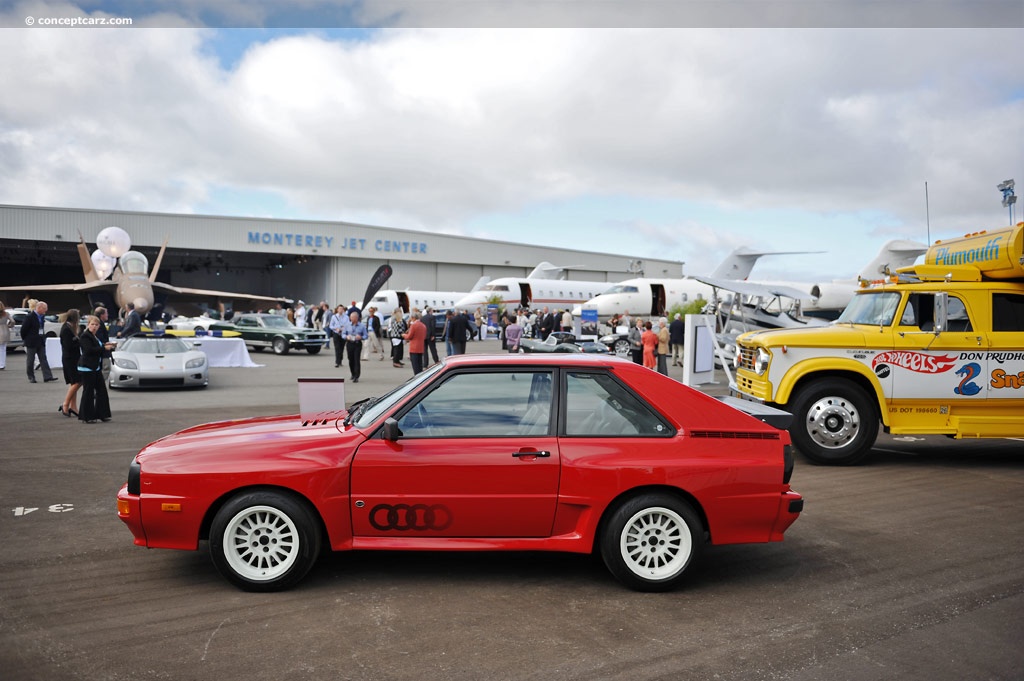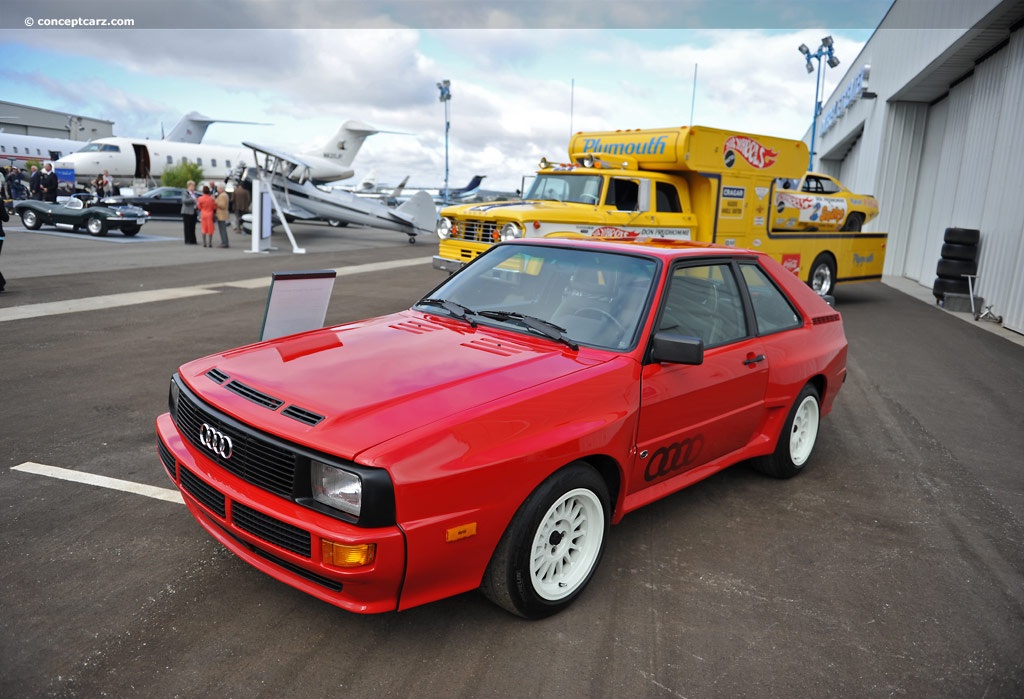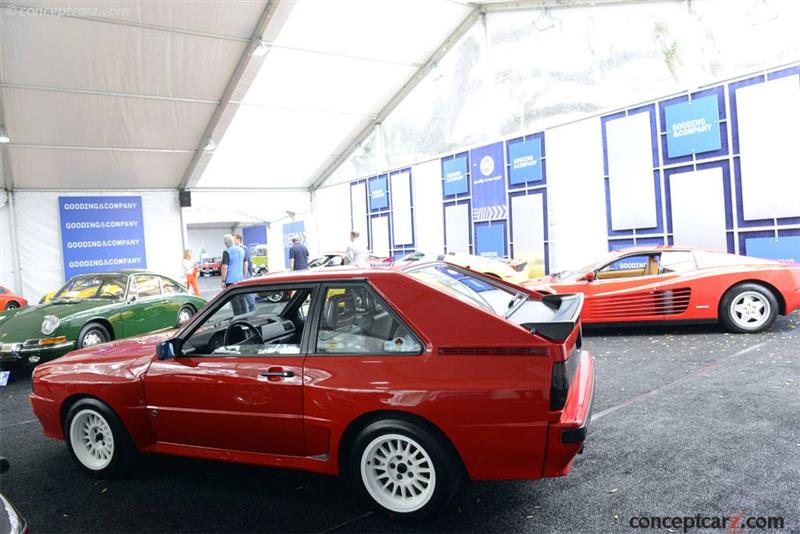Audi introduced its permanent all-wheel-drive system on the Audi 80-based Quattro Coupe (known today as the Ur-Quattro) in 1980, and it soon became a defining feature of the brand. It allowed drivers to vary the among of power fed to each end of the car while at speed, which proved advantageous while traveling on the vast array of surfaces and stages over which Rallying was run. As other automotive brands began to make the revolutionary change, the World Rally Championship responded by introducing a new Group B category giving contenders three classes from which to compete - Group N was for standard production cars; Group A was for modified production cars; and Group B was for modified sports cars. 
Coupe
Chassis #: WAUZZZ85ZEA905058
View info and history
Auction entries : 1The Group B category was virtually unbridled and allowed Audi to compete with its Quattro all-wheel-drive system. Homologation rules stated that only 200 road-going examples of each car were necessary for sale to the public. These relaxed regulations allowed for intensely competitive racing since automakers were no longer had to worry about mass producing models and build racing cars.For the first few years, Audi essentially campaigned a Group 4 Quattro, before engineers in Ingolstadt, Germany, created the Sport Quattro. The Ur-Quattro ('original Quattro') had proven competitive and its permanent all-wheel-drive system had made it a dominant force on the varied rally stage surfaces. Its long wheelbase, monocoque chassis, and balance issues caused by its longitudinally mounted engine proved to be Achilles heels compared to the purpose-built racers such as the Lancia 037. Audi engineers worked clandestinely to address these issues, far away from the company's road car operations. The wheelbase was shortened 12.6 inches between the B- and C-pillars, and the steel monocoque shell was built offsite by Baur and fitted with GRP, aluminum, fiberglass, and carbon-Kevlar panels to further reduce weight. The five-cylinder engine had an alloy-block, a 2,133-cubic centimeter displacement, and four valves per cylinder. With the help of a KKK-K27 turbocharger rated at 17 psi (1.05 bar), the engine produced around 450 horsepower in competition guise. Due to the size of the turbocharger, the engine's displacement needed to be lower to comply with FIA regulations. Regardless, the Sport Quattro competed against cars in the 3,000 cubic centimeter category. With a zero-to-sixty mph time of 4.8 seconds, it was one of the quickest cars ever built for road use when it debuted. Stopping power was provided by AP four-piston racing brakes that had been slotted and ventilated, as developed for the Porsche 917. The windscreen was sourced from the Audi 80 and was positioned more upright, allowing improved visibility and reduced reflection from the dashboard. Some of the Ur-quattro's monocoque cabin was retained, and the body had pronounced fender flares, allowing for the installation of 9-inch wide Ronal spoked alloy wheels. 
Coupe
Chassis #: WAUZZZ85ZEA905058
View info and history
Auction entries : 1With drivers such as Stig Blomqvist, Hannu Mikkola, Michèle Mouton, and Walter Röhrl, the Audi Sport dominated the WRC throughout the 1984 season. Its last victory was by Stig Blomqvist and Björn Cederberg, who raced one in early November 1984, at the Rallye Côte d'Ivoire in Africa, where the team also claimed the manufacturers' title.Just 214 Sport Quattros were built, and in Germany, they retailed for over 200,000 Deutschmarks. 161 were homologated as road versions (Some sources state 224 were built with an estimated 164 competed in road-going trim). Road-going models had a Bosch HI-Jetronic fuel injection system, 302 brake horsepower, and 258 foot-pounds of torque. Advanced features such as a selectable ABS system allowed drivers to tailor the vehicle to various road conditions. Equipped with nine-inch-wide Ronal alloy wheels, the road-going Sport Quattro retained the aggressive stance of its competition sibling while offering performance that was no less aggressive than its racing counterparts. The turbo-lag was profuse and commanded respect. Along with the Sport Quattro, Group B racing spawned the lighter and mid-engined Peugeot 205 T16 and Lancia Delta S4 before the racing category ended at the close of 1986.
by Daniel Vaughan | Aug 2020

Coupe
Chassis #: WAUZZZ85ZEA905058
View info and history
Auction entries : 1

Coupe
Chassis #: WAUZZZ85ZEA905058
View info and history
Auction entries : 1
by Daniel Vaughan | Aug 2020
Related Reading : Audi Sport Quattro History
The street-legal Audi Sport Quattro was produced to homologate the car for FIA Group B rally racing from 1984 to 1986. 214 were produced in total. The Sport Quattro was based on the road-going Audi Quattro coupe, with significant modifications to optimize it for rally racing. The wheelbase and body were shortened by 12.6-inches and the body was made from lightweight fiberglass and Kevlar body panels.....
Continue Reading >>
Continue Reading >>
Similar Automakers
Similarly Sized Vehicles
from 1986
Audi Monthly Sales Volume
March 2023
52,763
1986 Audi Sport Quattro Vehicle Profiles
Recent Vehicle Additions
Performance and Specification Comparison
Sport Quattro Specification Comparison by Year
Year
Production
Wheelbase
Engine
Prices
Related Automotive News

Audi brings vision of future mobility to Monterey Car Week
Audi sphere concept cars, the skysphere, grandsphere, and urbansphere, will showcase Audis vision of the future of premium electric mobility at the Quail
North American debut of the all-electric, one-of-a-kind Audi S1 e-tron quattro Hoonitron, in...

How legends sound: The revolution of the Audi five-cylinder engine
Legendary engine proves successful concept from racing to series production
Five-cylinder engine returns with legendary performance in 2022 Audi RS 3
Since 2010, 2.5-liter TFSI five cylinder engine voted Engine of the Year nine consecutive time...

Gripped By Quattro – Celebrating Forty Years Of The Audi All-Wheel Drive Road And Rally Icon
Forty years of quattro
Harald Demuth – Developing the new secret Audi rally weapon
David Ingram – Hoisting the quattro high above the capital
Phil Short – Winning in a rally quattro first time out
Graham Rood – Plotting the route to victor...

THE AUDI FIVE-CYLINDER AT 40 – A LEGACY LIVES ON
Evocative Audi powerplant celebrated for its mighty on-road performance and significant motorsport success reaches a historical milestone
Five-cylinder engine delivering 136PS presented for the first time in 1976 in the Audi 100
Highly successful...

ALL-NEW FORD FOCUS RS MAKES GLOBAL AUTO SHOW DEBUT; PIONEERS INNOVATIVE AWD AND PERFORMANCE TECHNOLOGIES
Fords all-new Focus RS makes global show debut in Geneva introduces advanced performance technologies to deliver the ultimate fun-to-drive experience
Third-generation Focus RS pioneers innovative Ford Performance All-Wheel-Drive with Dynamic Torq...


















